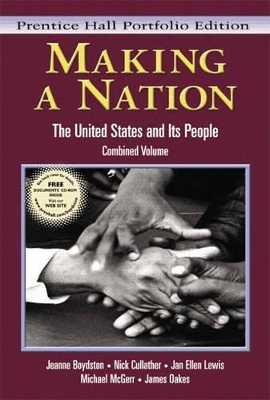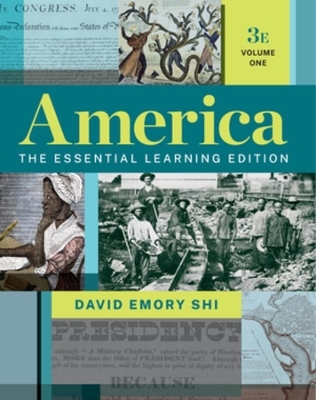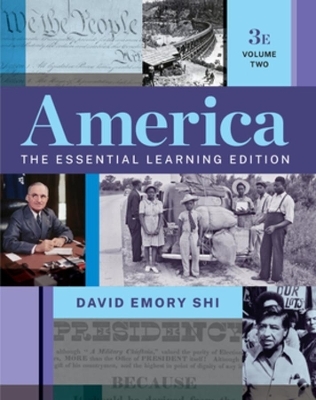
Making a Nation
Pearson
978-0-13-111454-8 (ISBN)
- Titel ist leider vergriffen;
keine Neuauflage - Artikel merken
Making a Nation, Concise Edition focuses on the relationships that shape and define human identity—culture, race, gender, class and sectional relations. The text shows that politics and the economy do not simply shape, but in turn are shaped by, the lives and cultural values of ordinary men and women. This political economy approach allows students to see the links between the particular and the general, between large and seemingly abstract forces such as globalization and political struggle, and the everyday decisions made by ordinary men and women.
Jeanne Boydston is Professor of History at the University of Wisconsin-Madison. She is the author of Home and Work: Housework, Wages, and the Ideology of Labor in the Early American Republic, coauthor of The Limits of Sisterhood: The Beecher Sisters on Women's Rights and Woman's Sphere, coeditor of The Root of Bitterness: Documents of the Social History of American Women (second edition), as well as author of articles on the labor history of women in the early republic. Professor Boydston teaches in the areas of early republic and antebellum United States history and United States women's history to 1870. Her BA and MA are from the University of Tennessee, and her PhD is from Yale University. Nick Cullather is Associate Professor at Indiana University, where he teaches courses on the history of United States foreign relations. He is on the editorial boards of Diplomatic History and the Encyclopedia of American Foreign Policy, and is the author of Illusions of Influence (1994), a study of the political economy of United States-Philippines relations, and Secret History (1999), which describes a CIA covert operation against the government of Guatemala in 1954. He received his AB from Indiana University and his MA and PhD from the University of Virginia. Jan Ellen Lewis is Professor of History and Director of the Graduate Program at Rutgers University, Newark. She also teaches in the history PhD program at Rutgers, New Brunswick and was a Visiting Professor at Princeton University. A specialist in colonial and early national history, she is the author of The Pursuit of Happiness: Family and Values in Jefferson's Virginia (1983), and co-editor of An Emotional History of the United States (1998) and Sally Hemings and Thomas Jefferson: History, Memory, and Civic Culture (1999). She is currently completing an examination of the way the Founding generation grappled with the challenge presented to an egalitarian society by women and slaves and a second volume of the Penguin History of the United States. She received her AB from Bryn Mawr College, and MAs and PhD from the University of Michigan. Michael McGerr is Associate Professor of History and Associate Dean for Graduate Education in the College of Arts and Sciences at Indiana University-Bloomington. He is the author of The Decline of Popular Politics: The American North, 1865-1928 (1986). With the aid of a fellowship from the National Endowment for the Humanities, he is currently writing a book on the rise and fall of Progressive America. Professor McGerr teaches a wide range of courses on modern American history, including the Vietnam War, race and gender in American business, John D. Rockefeller, Bill Gates, and the politics of American popular music. He received his BA, MA, and PhD degrees from Yale University. James Oakes is Graduate School Humanities Professor and Professor of History at the Graduate Center of the City University of New York, and has taught at Purdue, Princeton, and Northwestern. He is author of The Ruling Race: A History of American Slaveholders (1982) and Slavery and Freedom: An Interpretation of the Old South (1990). In addition to a year-long research grant from the National Endowment for the Humanities, he was a fellow at the Center for Advanced Study in the Behavioral Sciences in 1989-90. His areas of specialization are slavery, the Civil War and Reconstruction, and the history of American political thought. He received his PhD from The University of California at Berkeley.
(NOTE: Volume I includes Chapters 1-16 and Volume II includes Chapters 16-31. All chapters conclude with a Conclusion, Chronology, and Suggestions for Further Readings.)
1. Worlds in Motion, 1450-1550.
Vignette: Christopher Columbus: World Traveler. The Worlds of Christopher Columbus. The World of the Indian Peoples. Worlds in Collision. The Biological Consequences of Conquest. Onto the Mainland.
2. Colonial Outposts, 1550-1650.
Vignette: Don Luís de Velasco Finds His Way Home. Pursuing Wealth and Glory Along the North American Shore. Spanish Outposts. New France: An Outpost in the Global Political Economy. New Netherland: The Empire of a Trading Nation. England Attempts an Empire.
3. The English Come to Stay, 1600-1660.
Vignette: The Adventures of John Rolfe. The First Chesapeake Colonies. The Political Economy of Slavery Emerges. A Bible Commonwealth in the New England Wilderness. Dissension in the Puritan Ranks.
4. Creating the Empire, 1660-1720.
Vignette: Tituba Shapes Her World and Saves Herself. The Plan of Empire. New Colonies, New Patterns. The Transformation of Virginia. New England Under Assault. The Empire Strikes. Massachusetts in Crisis. French and Spanish Outposts. Conquest, Revolt, and Reconquest in New Mexico.
5. The Eighteenth-Century World: Economy, Society, and Culture, 1700-1775.
Vignette: George Whitefield: Evangelist for a Consumer Society. The Population Explosion of the Eighteenth Century. The Transatlantic Political Economy: Producing and Consuming. The Varieties of Colonial Experience. The Head and the Heart in America: The Enlightenment and Religious Awakening.
6. Conflict on the Edge of the Empire, 1713-1774.
Vignette: Susannah Willard Johnson Experiences the Empire. The Wars for Empire. The Victory of the British Empire. Enforcing the Empire. Rejecting the Empire. A Revolution in the Empire.
7. Creating a New Nation, 1775-1788.
Vignette: James Madison Helps Make a Nation. The War Begins. Winning the Revolution. The Challenge of the Revolution. A New Policy in the West. Creating a New National Government.
8. The Experiment Undertaken, 1789-1800.
Vignette: Washington's Inauguration. Conceptions of Political Economy in the New Republic. Factions and Order in the New Government. A State and Its Boundaries. America in the Transatlantic Community.
9. Liberty and Empire, 1800-1815.
Vignette: Gabriel's Conspiracy for Freedom. Voluntary Communities in the Age of Jefferson. Jeffersonian Republicanism: Politics of Transition. Liberty and an Expanding Commerce. The Political Economy of an “Empire of Liberty”. The Second War with England.
10. The Market Revolution, 1815-1824.
Vignette: Cincinnati: Queen of the West. New Lands, New Markets. A New Nationalism. Firebells in the Night. The Political Economy of Regionalism.
11. Securing Democracy, 1820-1832.
Vignette: Jackson's Election. Perfectionism and the Theology of Human Striving. The Common Man and the Political Economy of Democracy. The Democratic Impulse in Presidential Politics. President Jackson: Vindicating the Common Man.
12. Reform and Conflict, 1828-1836.
Vignette: Free Labor Under Attack. The Growth of Sectional Tension. The Political Economy of Early Industrial Society. Self-Reform and Social Regulation.
13. Manifest Destiny, 1836-1848.
Vignette: Mah-i-ti-wo-nee-ni Remembers Life on the Great Plains. The Setting of the Jacksonian Sun. The Political Economy of the Trans-Mississippi West. Slavery and the Political Economy of Expansion.
14. The Politics of Slavery, 1848-1860.
Vignette: Frederick Douglass. The Political Economy of Freedom and Slavery. Slavery Becomes a Political Issue. Nativism and the Origins of the Republican Party. A New Political Party Takes Shape. An “Irrepressible” Conflict? The Retreat from Union.
15. A War for Union and Emancipation, 1861-1865.
Vignette: Edmund Ruffin. From Union to Emancipation. Mobilizing for War. The Civil War Becomes a Social Revolution. The War at Home. The War Comes to a Bloody End.
16. Reconstructing a Nation, 1865-1877.
Vignette: John Dennett Visits a Freedman's Bureau Court. Wartime Reconstruction. Presidential Reconstruction, 1865-1867. Congressional Reconstruction. The Retreat from Republican Radicalism. Reconstruction in the North. The End of Reconstruction.
17. The Triumph of Industrial Capitalism, 1850-1890.
Vignette: Rosa Cassettari. The Political Economy of Global Capitalism. The Rise of Big Business. A New Social Order. Clearing the West for Capitalism. The Economic Transformation of the West.
18. Cultural Struggles of Industrial America: 1850-1895.
Vignette: Anthony Comstock's Crusade Against Violence. The Varieties of Urban Culture. The Elusive Boundaries of Male and Female. Immigration as a Cultural Problem. The Creation of High Culture. Artistic Realism Embraces Urban and Industrial America.
19. The Politics of Industrial America, 1870-1892.
Vignette: The “Crusade” Against Alcohol. Two Political Styles. Economic Issues Dominate National Politics. Government Activism and Its Limits. Middle Class Radicalism. Discontent Among Workers.
20. Industry and Empire, 1890-1900.
Vignette: Dealmaking in the White House. The Crisis of the 1890s. A Modern Political Economy. The Retreat from Politics. American Diplomacy Enters the Modern World.
21. A United Body of Action, 1900-1916.
Vignette: Alice Hamilton. Toward a New Politics. The Progressives. Progressives in State and Local Politics. The Presidency Becomes “The Administration.” Rival Visions of the Industrial Future.
22. A Global Power, 1914-1919.
Vignette: Walter Lippmann. The Challenges of Revolution and Neutrality. The Drift to War. Mobilizing the Nation and the Economy. Over There. The Black Cloud in the East.
23. The 1920s.
Vignette: “The Queen of Swimmers.” A Dynamic Economy. A Modern Culture. The Limits of Modern Culture. A “New Era” in Politics.
24. A Great Depression and a New Deal, 1929-1939.
Vignette: Sidney Hillman and the Search for Security. The Great Depression. The First New Deal. The Second New Deal. Crisis of the New Deal.
25. The Second World War, 1941-1945.
Vignette: A. Phillip Randolph. Island in a Totalitarian Sea. Turning the Tide. Organizing for Production. Between Idealism and Fear. Closing with the Enemy.
26. The Cold War, 1945-1952.
Vignette: The Fall of Esther and Stephen Brunauer. The Origins of the Cold War. Fighting the Cold War Abroad. The Reconversion of American Society. The Frustrations of Liberalism. Fighting the Cold War at Home.
27. The Consumer Society, 1950-1960.
Vignette: E.J. Korvettes. Living the Good Life. A Homogenous Society? The Eisenhower Era at Home and Abroad. Challenges to the Consumer Society.
28. The Rise and Fall of the New Liberalism, 1960-1968.
Vignette: “We Would Never Be Beaten”: Vietnam. The Liberal Opportunity. Implementing the Liberal Agenda. Winning Civil Rights. Fighting the Cold War. The American War in Vietnam. The Great Society Comes Apart.
29. Living with Less, 1968-1980.
Vignette: “Panic at the Pump,” 1973-1974. A New Crisis: Economic Decline. Confronting Decline: Nixon's Strategy. Refusing to Settle for Less: Struggles for Rights. Backlash: From Radical Action to Conservative Reaction. Political Crisis: Three Troubled Presidencies.
30. The Triumph of a New Conservatism, 1980-1988.
Vignette: The Trumps' American Dream. A New Conservative Majority. The Reagan Revolution at Home. The Battle Over Conservative Social Values. The Limits of the New Conservatism.
31. A New America?, 1989—.
Vignette: Felix Andreev and “The Blessing of America.” A New Economy. Political Deadlock. Struggles Over Diversity and Rights. From the Cold War to the War on Terrorism.
| Erscheint lt. Verlag | 25.2.2003 |
|---|---|
| Sprache | englisch |
| Gewicht | 1080 g |
| Themenwelt | Geisteswissenschaften ► Geschichte ► Regional- / Ländergeschichte |
| ISBN-10 | 0-13-111454-9 / 0131114549 |
| ISBN-13 | 978-0-13-111454-8 / 9780131114548 |
| Zustand | Neuware |
| Haben Sie eine Frage zum Produkt? |



